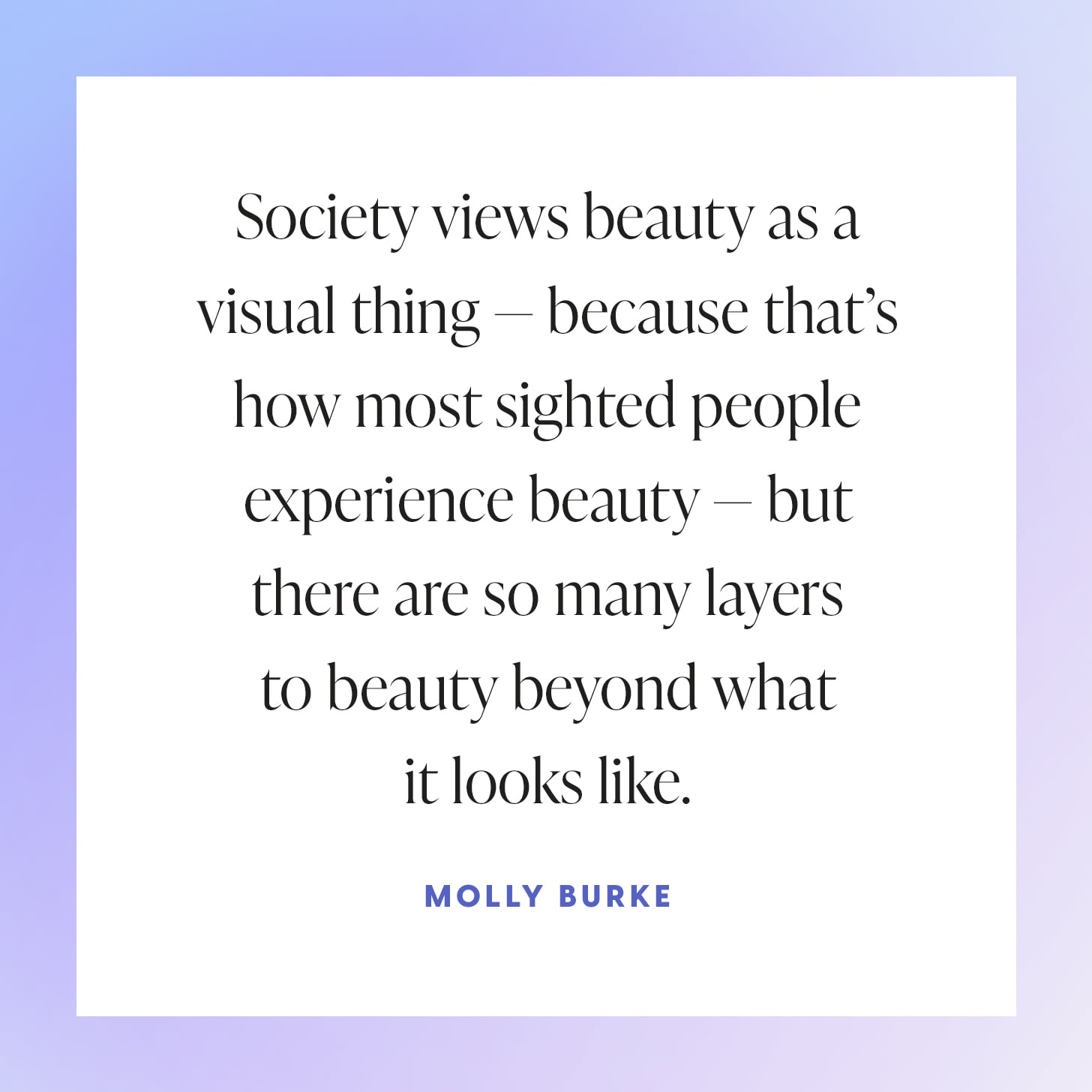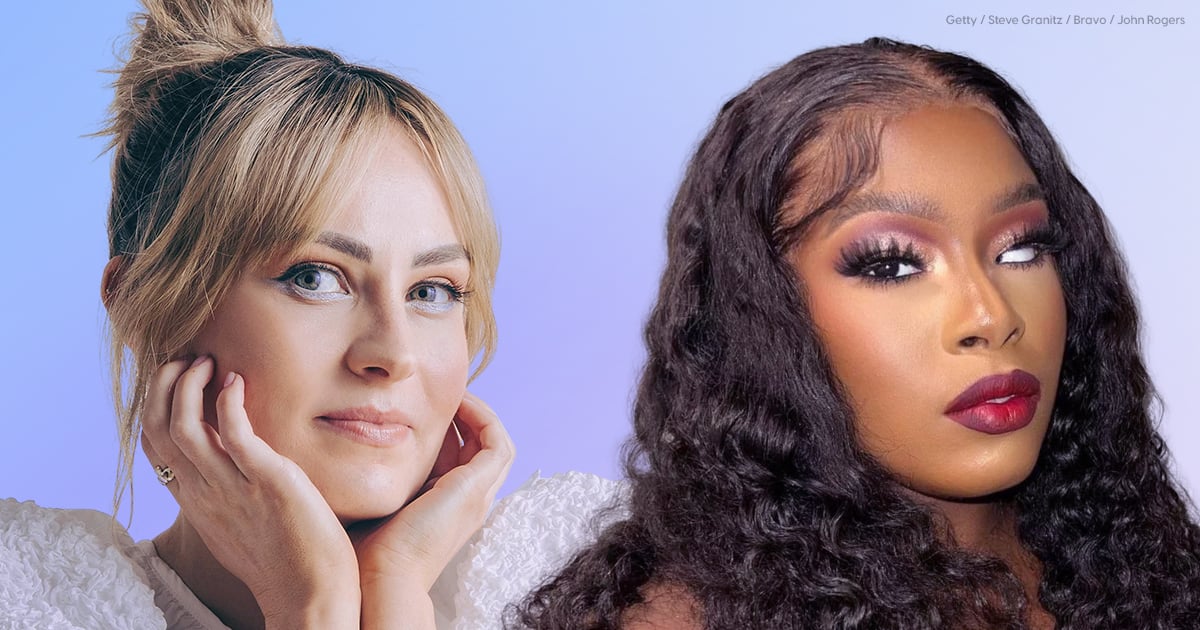
Image source: Molly Burke / Talya Reynolds / Photo illustration by Michelle Alfonso
If the beauty industry has shown us anything over the past few decades, it’s that makeup is for everyone. People of all genders, skin tones, ages, sexual orientations and abilities can experience the power of transformation — whether it’s applying red lipstick in the office or performing a glitter cut crease for a TikTok tutorial. And while makeup is recognized primarily as a visual medium, it is enjoyed by many in the visually impaired community.
“Society sees beauty as something visual — because that’s how most sighted people experience beauty — but beauty has so many layers beyond what it looks like,” she says Molly Burke, YouTuber and content creators. Burke was diagnosed with a genetic disorder called retinitis pigmentosa at the age of 4 and lost most of her sight at the age of 14. “I’m fortunate that I feel as confident with makeup as I do without because I can’t see myself. I don’t do it because I like the way it transforms my appearance, I do it because I love the elements of self-expression and self-care. I love that I take 20 minutes every morning to take care of my skin, do my makeup and choose an outfit that will show the world how I feel that day.”
“I’m fortunate that I feel just as confident with makeup as I do without because I can’t see myself… I do it because I love self-expression.”
Burke discovered her passion for beauty at a young age through her mother. Although Burke was born blind, she still had some sight as a child and grew up watching her mother apply lipstick. Over time, Burke’s eyesight slowly deteriorated, but her love of makeup never waned. When she turned 12, her mother agreed to let her experiment and, not knowing how to teach someone with visual impairment how to use cosmetics, she enlisted the help of professionals. That Christmas, she took Burke to a MAC counter and “had a makeup artist to source age-appropriate products. Then the makeup artist built a full routine for me and taught me which products went where.”
Once Burke had her gear and a rudimentary idea of how to apply her makeup, it all boiled down to practicing her technique over and over again. Practice is a bonding experience for makeup users, but unlike her sighted peers, Burke couldn’t rely on her eyesight to gauge her progress. “Sometimes I’d go out with mascara all over my face and my parents would burst out laughing very lovingly,” she says. “At the time there was no one blindly teaching me how to do it. I didn’t have a blind older friend or anyone I could look up to on social media who was blind. I did everything just by trial and error. “
Over time, Burke not only learned about the products in her arsenal and how to use them, but also learned some helpful tricks that helped her rely on her skills without being able to rely on her eyesight. “Something that was useful for me in the beginning was using a sample-size mascara,” says Burke. “Having a shorter wand gave me more control because my hand was so much closer to my eye. Even shorter makeup brushes made it a lot easier for me. I would also count the number of times I’d made a line with the eyeshadow pan and then count while massaging the product into my eyelid.”
Over the years, she has discovered other makeup application techniques that she finds helpful, which she then shares online with her followers and YouTube subscribers. Burke may not have had a blind YouTuber to rely on growing up, but she definitely wants to be someone for others to learn from.
Since launching her YouTube channel in 2014, Burke has grown as a content creator in beauty, fashion, travel and lifestyle, marking a monumental shift in how people with disabilities are represented on social media. “Going blind was the darkest time of my life,” says Burke. “I was really struggling and I knew I could give up or try to find a way to turn this pain into meaning. The fact that 14 years later I’m living with a purpose, being able to do what I love and actually help other blind people to feel less alone – that’s the most incredible experience.”
As creators like Burke emerged and thrived on social media, it inspired others in the visually impaired community who also love makeup to do the same. This is at Talja Reynoldsan Atlanta makeup artist who suffers from two degenerative eye diseases – squinting and coloboma – which prevent her from seeing with her left eye. Growing up, Reynolds was bullied because of her disability, so makeup became an escape route. It soon became one of her greatest passions.
Like Burke, Reynolds built her skills through practice, and while she can see out of her right eye, she still faces challenges when it comes to makeup. “Lashes have always been one of the hardest things for me because I have to close my right eye to get the lashes close to the lash line,” she says. “Without my right eye I don’t have the sight to see where to put the whip, so I have to use my other senses and really visualize my face and where to put the whip.”
Though their circumstances aren’t the same, both Burke and Reynolds have had to adjust their routines and use beauty products that weren’t designed for them. While some brands have made strides in developing more accessible packaging, much more needs to be done.
 Image source: Photo by Talya Reynolds
Image source: Photo by Talya Reynolds
There is no way to make the beauty industry more inclusive for the visually impaired community. And you don’t have to look further than Burke and Reynolds to see how accessible beauty can take many forms. Although both are women legally blind, they, pun intended, see the world very differently. Therefore, when a brand creates accessible products, it is important that they understand visual impairment from a variety of different perspectives.
“There are a number of brands that are putting Braille on their packaging and while it’s far from standard and I can certainly criticize the approach, I prefer to celebrate the small changes because we can’t expect perfection overnight ‘ Burke says. “Small changes are still positive changes in the right direction, even if they aren’t knocked out of the park right away. Also, it is very easy for brands to highlight the QR codes on their packaging. That way, as a blind consumer, I can feel where the QR code is, I can scan it with apps on my phone, and then my phone can read me the product name and content.”
Still, braille and raised QR codes are just the tip of the iceberg when it comes to how brands can become more inclusive. Less than 10 percent of legally blind people can do this read Braille and for those who can, Braille is often only included on single-use packaging—not on the products themselves. This makes tactile symbols a game changer for those with severe or total blindness.
For those who are visually impaired or partially blind, they can see accessible beauty through a different lens. While they may not read braille or use QR codes to shop independently, color-coded products can make a world of difference. Additionally, products that amplify the vision they hold can help along the way. “Magnifying mirrors are a useful gadget,” says Reynolds. “They really help me see the small details with my right eye and that’s a plus. Or even something as simple as an eyeliner stamp was really beneficial because you know that spoiling your liner can mess up your entire look.”
For brands to be more accessible and inclusive, they need to work with developers like Burke and Reynolds who understand exactly where to make changes. Although they didn’t choose their circumstances, they strive to make the world a better place for people with visual impairments. Burke is making a name for herself by sharing her experiences of living as a blind person in a sighted world and sharing her seasoned tips and tricks with the visually impaired. For Reynolds, she transforms others with her makeup artistry and leaves a lasting impression.
 Image source: Illustration by Michelle Alfonso
Image source: Illustration by Michelle Alfonso
“I remember doing prom makeup for three sisters one of my first years doing makeup professionally,” says Reynolds. “[One of them was] on my chair and her sister said, ‘Be careful when you step over her eye.’ She explained that her sister has a prosthetic eye that she is very insecure about. I remembered seeing this girl at school and she always wore bangs. I used to do the same thing and tried to do everything I can to fix it. But now I feel like God made me this way for a reason.”
Reynolds decided to cheer her up. “I said to her, ‘You’re beautiful. Never feel like you’re less than Never detract from your beauty; you’re special in your own way,’” she says. “I feel like that gave her the confidence to really go all out with her prom makeup. It made me feel good that I made her feel beautiful because not only did I do her makeup, but I connected with her on a deeper level.”
Far too often, the world of the able-bodied focuses on what disabled people can’t do. However, if you learned anything from Molly Burke and Talya Reynolds, it’s that people with disabilities are resilient, adaptable, and creative. They have entered a world that presents them with challenges and they are finding ways to overcome them. Those in the visually impaired community continue to defy society’s expectations of them — all while sporting a bright pink lip or a sharp cat’s eye.
Image Credit: Molly Burke / Talya Reynolds / Photo Illustration by Michelle Alfonso
